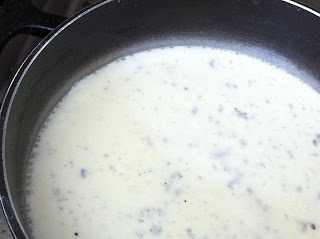The wedding took place in a little town called Blain. The reception was at the home of our friends grandfather. Home is too modest a word for where he lived. In reality it is a "mini-chateau". Grand by American standards, mini when compared to the chateau of the Loire Valley.
At the reception they had a seared a bunch of wonderful hors d'oeuvres stations placed throughout the grounds of the estate, they even had a foie gras station, I was in heaven.
The whole event seemed like it was out of a story book.
We were invited to have brunch with the family the next day, which we felt was an enormous honor. One of the dishes served at brunch was the most amazing goose rillettes. Wow! I'd eaten rillettes a few times on this trip and had even made some at home, but this stuff was like none I had ever tried.
The flavor was wonderful, the texture is what made it.
I had made rillettes once before this trip, but until I tasted that goose, I thought my attempt had been pretty good.
This stuff raised the bar.
I resolved that day to make rillettes again and do a better job on the texture.
When I started to make this batch, I decided to have it entirely hand made. In the past I had used a mixer to break up the meat and the final product was too fine and the texture and taste paled in comparison to the stuff at brunch.
Since I have never in my life had enough goose legs "lying about" to have a go at rillettes, I resolved to make my next run with pork.
I searched my cook books and the Internet for a suitable recipe and all of them had what I considered a fatal flaw or two.
This recipe is a marriage of four or five with some adjustments thrown in throughout the cooking process:
2.5 lb pork shoulder (pork butt)
1/5 C Calvados (or apple brandy if that is what you have)
4 Bay Leaves
6 Thyme stems with leaves
10 Black Peppercorns
4 Juniper Berries
1.5 C Goose Fat (Lard will work just fine). See below.
2-3 C Rich Chicken Stock
Cut the meat into small cubes and place into a large stainless steel or glass bowl.
Heat your oven to 225-250F.
When the meat is browned add it to a roasting pan. Continue browning until all of the meat has been browned.
Add some chicken stock to just cover the meat and the rest of the fat and cover tightly.
Cook in the oven for three hours or so. The meat should be tender and come part easily.
Let the meat cool in the liquid until it can be handled. Remove it from the liquid and break it up with your hands and put into a large bowl.
Pack the meat into ramekins or jars leaving about 3/4" room at the top. Refrigerate them until cold.
Strain the cooking liquid and pull the fat from the top. Pour a little of this on top of the rillettes, about a 1/4" and back to the fridge.
Once the fat has set up, close the lids. Keep them in the refrigerator. They will last a long time in there protected by the fat. Once you open one and break the layer of fat, you should eat the whole thing in a few days. I usually serve mine with a nice baguette or good crackers.
That should not be hard to do though as ours usually only last an hour or two -even if the bread runs out!

























































